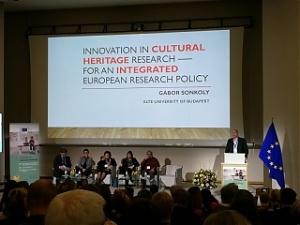Culture, EU – Baltic States, Forum, Innovations, Technology
International Internet Magazine. Baltic States news & analytics
Thursday, 25.04.2024, 05:36
Innovation in cultural heritage
 Print version
Print version |
|---|
European states are facing with numerous challenges in
trying to protect and benefit from its cultural heritage. Research and
innovation – through use of smart technology, digitalisation and other advanced
solutions – can assist to mitigate these challenges.
The European Commission revealed some actions to be taken
in order to contribute to long-term synergies between science, research,
innovation and culture for the benefit of cultural heritage. These include
providing digital access to physically inaccessible sites, helping preserve
priceless artifacts, and exploring new ways of valuing cultural heritage for
creative industries, to name a few.
Commission’s
view on “innovative cultural heritage”
The Commission previously underlined that “cultural
heritage consists of cultural and creative resources of a tangible or
intangible nature, with a value for society that has been publicly recognised
in order to preserve them for future generations. It includes natural, built
and archaeological sites, museums, monuments, artworks, historic cities, literary,
musical, audiovisual and digital works, and the knowledge, practices and
traditions of European citizens”. See more in:
http://europa.eu/rapid/press-release_IP-16-2905_en.htm
Over 300,000 people are already employed in the member
states’ cultural heritage sector, and with 453 inscribed sites, European region
accounts for almost half of UNESCO's World Heritage List. In addition, 7.8
million jobs in the EU are indirectly linked to heritage, e.g. through tourism,
interpretation and security.
With this in mind, and especially at a time when cultural
treasures are under threat and are being deliberately destroyed in conflict
zones, the Commission considered that cultural heritage deserved a European
Year in 2018; the decision was adopted in May 2017).
Commissioners’
opinion
Several Commissioners commented on the innovative approaches to cultural heritage. Thus,Commissioner Navracsics in charge of education and culture said that it has been the states’ responsibility to preserve cultural heritage for the next generations. Research and innovation can offer advanced solutions and technologies to achieve this. During the present European Year of Cultural Heritage the Commission highlighted long-term projects aimed at protecting and promoting heritage.
Commissioner Moedas, in
charge of research, sciences and innovation underlined that protecting cultural heritage research
and innovation provided “limitless source where traditions meet with cutting-edge
technologies”. He stressed that the EU’s ambition was “to make Europe the world
leader in heritage-based innovation with support from Horizon 2020, the
EU's research and innovation funding programme”.
Commissioner Gabriel, in charge of digital economy and society, stressed that “technological and digital innovations have had a unique potential because they facilitate the access to national heritage in a way that has never been achieved in our history”. She mentioned, e.g. the online platform Europeana, which was not just a digital vault that preserved cultural heritage but a channel and an open door to peoples’ past, present and future."Through Europeana, citizens and the Cultural and Creative Industries (CCIs) can access European culture for the widest possible variety of purposes. See more in:
https://ec.europa.eu/digital-single-market/en/europeana-european-digital-library-all
Innovation
in cultural heritage research
In the Commission’s policy review “Innovation
in Cultural Heritage Research”, it assessed the EU-funded research on
cultural heritage and proposed improvements to the European Research Framework
after 2020. More in the brochure “Innovation in cultural heritage” at: https://publications.europa.eu/en/publication-detail/-/publication/1dd62bd1-2216-11e8-ac73-01aa75ed71a1/language-en/format-PDF/source-66949536
During 2014- 20, the EU is investing about €500 million in
research and innovation on cultural heritage. The so-called innovation
pillar of the European Year of Cultural Heritage consists of three
projects (run by the Commission, the EU states, the Council of Europe and
European universities) to improve Europeans' skills on cultural heritage,
involve citizens in making better decisions about cultural heritage, and
promote the role of science and technologies in cultural heritage.
More information in: = European Year of Cultural
Heritage 2018; = Horizon 2020 High-Level
Conference on Innovation and Cultural Heritage; = Video: Europe's Cultural Heritage;
= Infographic: Science,
innovation and cultural heritage. General
source: Commission press release (20.03.2018): http://europa.eu/rapid/press-release_IP-18-2061_en.htm








 «The Baltic Course» Is Sold and Stays in Business!
«The Baltic Course» Is Sold and Stays in Business!

